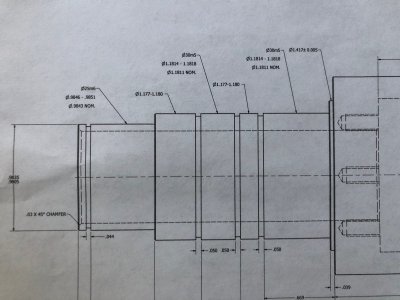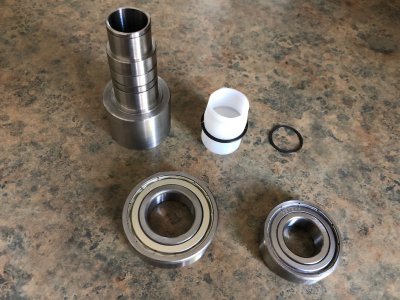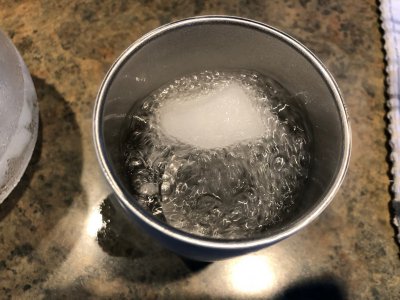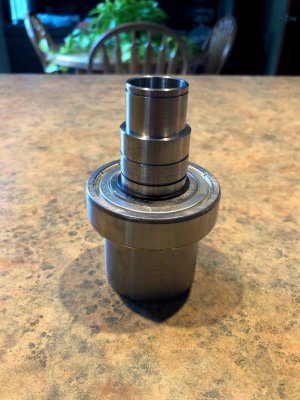- Joined
- Mar 26, 2018
- Messages
- 2,724
Been working on a spindle shaft project and thought I'd share a neat trick I "invented" (apparently everyone's been doing this, I just never heard of it).
I designed and machined a simple spindle shaft for the upper bearing section of my G0704 CNC mill - the stock one could not be modified to manage the spindle speeds I am running. Part of the design are some interference fit bearing seats in the ISO "m5" fit. For the 25mm and 30mm bearing seats, this results in a 0.0008" to 0.0012" interference fit. I don't own a press and I wanted to be delicate with the install. I did the math and figured out a thermal shrink would give me a hand installed fit, if I could get the temp difference enough. Steel has a CTE of roughly 0.0000065 in/in/*F so simply heating the bearing to its max temp of 250*F wouldn't accomplish the fit, I needed something closer to 325+*F temperature difference.
To get enough clearance, I used a 99% isopropyl alcohol and dry ice bath to shrink the shaft. This cooling bath can be made from things readily available at home. In my case, a vacuum insulated coffee mug, the alcohol, and some store bought dry ice. A Styrofoam container can also be used. The bath takes a bit of time to get down to temperature, but once it does, it settles at a whopping -120*F. At these temps the alcohol becomes viscous like a thin maple syrup which is pretty wild.
With the bearing baked in the oven to 250*F and the shaft at -120*F (waited about an hour for both items to settle on temp), the bearing slipped on by hand with no issue and firmly shrunk to the shaft.
The only drawback is that the isopropyl bath is very effective at stripping all of the oil from your parts, so you need to quickly apply a fresh protective oil or the shaft will flash rust.
Here's a section of the shaft drawing showing all the bearing seats. Yes, I hit all the tolerances on my lathe - no grinding - on my first go. Was pretty proud of that.

Shaft, two bearings, two helical snap rings (balanced for high speed), and a plastic install tool for the 30mm snap ring.

Shaft chilling in the dry ice bath. Dry ice sinks in the alcohol so I have one chunk below the part, and one resting above the part. When the bubbles slow to a very gentle bubbling, the part is at temperature.

And the bearing installed. I didn't do the smaller bearing yet because there is an end machining operation left to do.

I designed and machined a simple spindle shaft for the upper bearing section of my G0704 CNC mill - the stock one could not be modified to manage the spindle speeds I am running. Part of the design are some interference fit bearing seats in the ISO "m5" fit. For the 25mm and 30mm bearing seats, this results in a 0.0008" to 0.0012" interference fit. I don't own a press and I wanted to be delicate with the install. I did the math and figured out a thermal shrink would give me a hand installed fit, if I could get the temp difference enough. Steel has a CTE of roughly 0.0000065 in/in/*F so simply heating the bearing to its max temp of 250*F wouldn't accomplish the fit, I needed something closer to 325+*F temperature difference.
To get enough clearance, I used a 99% isopropyl alcohol and dry ice bath to shrink the shaft. This cooling bath can be made from things readily available at home. In my case, a vacuum insulated coffee mug, the alcohol, and some store bought dry ice. A Styrofoam container can also be used. The bath takes a bit of time to get down to temperature, but once it does, it settles at a whopping -120*F. At these temps the alcohol becomes viscous like a thin maple syrup which is pretty wild.
With the bearing baked in the oven to 250*F and the shaft at -120*F (waited about an hour for both items to settle on temp), the bearing slipped on by hand with no issue and firmly shrunk to the shaft.
The only drawback is that the isopropyl bath is very effective at stripping all of the oil from your parts, so you need to quickly apply a fresh protective oil or the shaft will flash rust.
Here's a section of the shaft drawing showing all the bearing seats. Yes, I hit all the tolerances on my lathe - no grinding - on my first go. Was pretty proud of that.

Shaft, two bearings, two helical snap rings (balanced for high speed), and a plastic install tool for the 30mm snap ring.

Shaft chilling in the dry ice bath. Dry ice sinks in the alcohol so I have one chunk below the part, and one resting above the part. When the bubbles slow to a very gentle bubbling, the part is at temperature.

And the bearing installed. I didn't do the smaller bearing yet because there is an end machining operation left to do.

Last edited:

